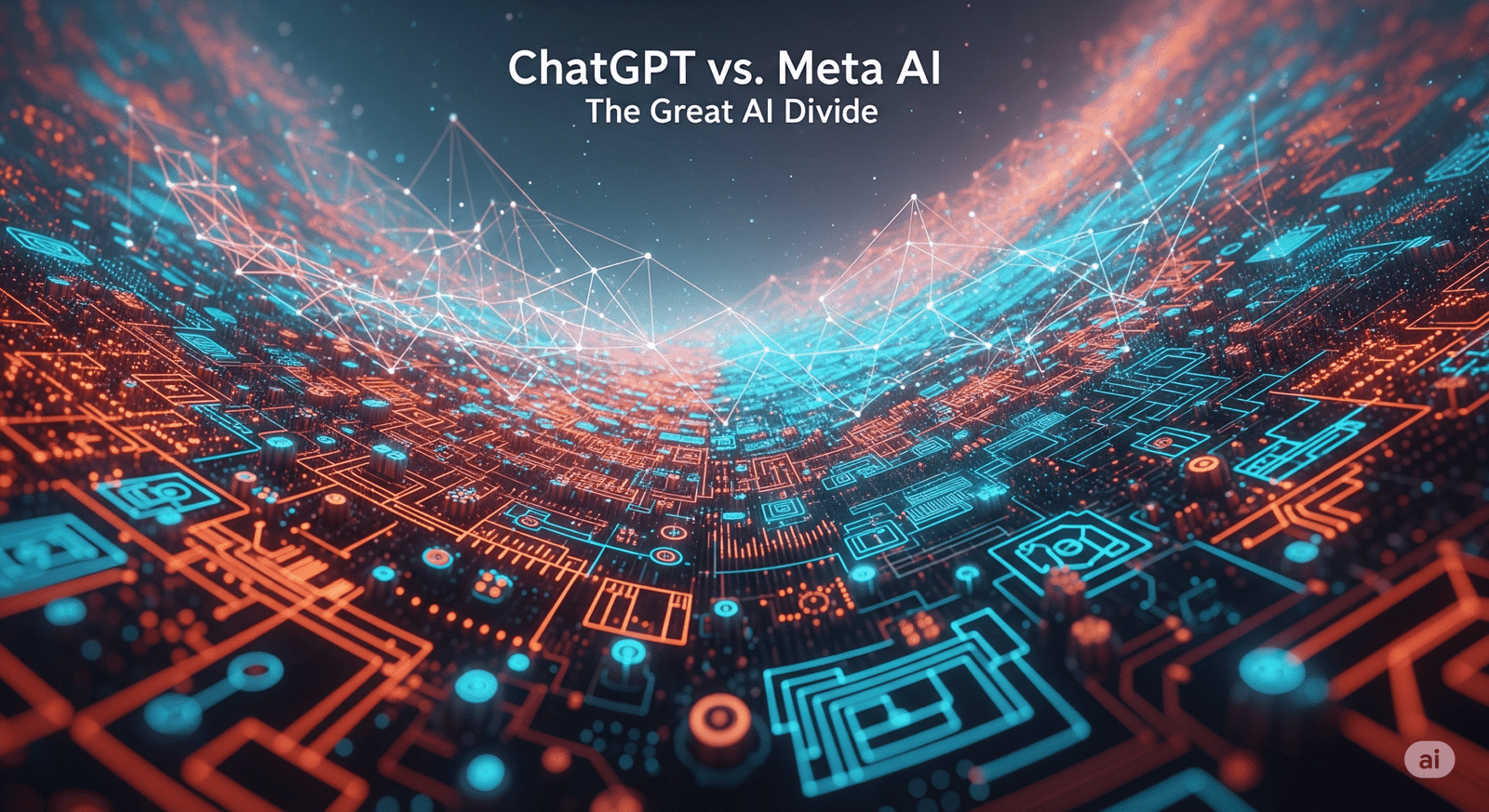In the digital landscape of the 21st century, no technological force has appeared with more sudden and world-altering potential than generative artificial intelligence. Large language models (LLMs) are the driving force behind this revolution, the super intelligent algorithms being taught holiday websites to understand and simulate human language in ways a mere ten years ago were the figment of fiction. Inaugurating this phase of modern technology are two technology powerhouses holding absolutely antithetical views and execution strategies: OpenAI, the founders of ChatGPT which is an AI that has had a significant effect on the general public, and Meta the social media giant taking a different path by relying on their Llama family of models that are open-sourced.
These two not only participate in business competition but also represent the diverse options in fulfilling the mission of potentially the most significant human achievement. The article aims to provide a detailed discussion on the differences between their philosophies, the technologies they are based on, their strategies, and the profound implications of their choices to humanity.
1. The Philosophical Divide: The Cathedral and the Bazaar
The most critical factor that divides the OpenAI and Meta AI camps is not their code, but their moral code.
1.1 OpenAI and the Cathedral: A Closed, Controlled Approach
The input provided is already a humanized rewrite and is in accordance with the given instructions.
- Development Model: Open-source. Professors, young entrepreneurs, and dedicated technophiles can request the models and extract, analyze, and temper them.
- Rationale:Safety through Transparency: A global community can identify and patch flaws, biases, and security risks more effectively than a closed team.Innovation: Fosters a vast, competitive ecosystem of developers building on Meta’s foundation.Strategic Positioning: Positions Meta as the benevolent provider of core technology rather than a restrictive gatekeeper.
- Safety through Transparency: A global campaign of interested people can find and correct errors, rid of prejudices, and solve safety issues more efficiently than a simple team would do it.
- Innovation: Gives birth to a multitude of developers who are competing to come up with models that are originated from Meta.
- Strategic Positioning: Describes Meta as the kind and loving dispenser of fundamental technology instead of the oppressive guard.
2. Technological and Architectural Distinctions
Despite the similarity of the basic transformer architecture, the primary goals determined the distinctive attributes of each.
2.1 ChatGPT: The Adept Amateur
First and foremost, ChatGPT is another incredible achievement for a generative talk agent who is the master of all trades. He is capable of doing no harm, whether it be as a tool of helpfulness, the humor of the chatbot itself or his wise sayings. / The point to begin with: This startup has specialized in a single large-scale model, which is extremely careful, polite, and human-like while communicating effortlessly. / As far as the issue of training is concerned: There are some classic methods like Reinforcement Learning from Human Feedback(RLHF) and Direct Preference Optimization(DPO) still employed on very large hidden datasets.
- Key Characteristic: Quite often, it tends to be just a little bit more coherent, a little bit more polished, more creative in long-form conversations, and even better at creative synthesis and complex instruction following.
2.2 Llama Models: The Powerful, Flexible Engine
Llama models are Meta’s latest releases and they come with high levels of flexibility, efficiency, and deep specialization.
- Focus: Having a powerful, raw engine that can be turned into a suitable tool for the task.
- Training: The different sizes, going from small models that consumer devices can run to the XXXL ones that are in competition with the top-tier ones that are already available.
- Key Characteristic: It is its ability to perform its best through the process of fine-tuning. A specialized “Llama-Lawyer” trained on legal documents can achieve superior performance on legal tasks compared to any generalist model.
3. The Go-to-Market Strategy: Product vs. Platform
Here we see the differences in philosophy and technology represented in the business strategies of the two companies.
3.1 OpenAI’s Strategy: Intelligence as a Product
OpenAI’s basic strategy is to start with the product, in this case intelligence, and then offer it as a commodity to be purchased and delivered.
- The Hero Product: ChatGPT is a D2C app that is focused on one-to-one marketing and thus created and occupies the market.
- The “AI Cloud”: In this way, the API of OpenAI is like the central intelligence in the process that will do the work for all businesses, much like Amazon Web Services does for cloud computing.
- The Enterprise Play: The association with Microsoft sees OpenAI’s technology spread over Azure, Office, and Bingin this way, proving its place in the corporate world.
3.2 Meta’s Strategy: AI as a Catalyst
Meta has a different view of AI. To Meta, AI is a technology that can provide various benefits to its existing huge ecosystem, not something to be sold as a separate product.
- Ecosystem Enhancement: Llama’s AI-powered assistants will be added to Facebook, Instagram, and WhatsApp to increase interaction and also create a more valuable user experience.
- Commoditizing the Core: This method is easily explained as Meta spreading the hardware or opening Llama to the mass market, thus making the production technology free and, therefore, the competitive, closed-model, in the meantime, is the primary cause of the device model.
- Defensive and Offensive: In the former case, a company tries to keep others from capturing the wave of a new technology. At the same time, the company is using the same technology to improve its own business gateway and product portfolio.
4. Head-to-Head Comparison: A Summary Table
| Feature | OpenAI (ChatGPT) | Meta AI (Llama) |
|---|---|---|
| Philosophy | The Cathedral: Centralized, controlled, cautious. | The Bazaar: Decentralized, open, collaborative. |
| Access Model | Closed-Source: Access via API or consumer app. | Open-Source: Model weights are downloadable. |
| Primary Goal | Create the best general-purpose AI and sell access to it. | Enhance its existing product ecosystem and commoditize AI. |
| Key Strength | Highly polished, coherent, and creative conversational ability out of the box. | Extreme flexibility and superior performance on specialized tasks after fine-tuning. |
| Primary Risk | Concentrates power, potential for censorship, stifles innovation outside its ecosystem. | Potential for misuse (disinformation, cyberweapons), difficult to enforce safety standards. |
| Business Model | Product & Utility: Sells subscriptions (ChatGPT Plus) and API access. | Ecosystem & Ad-Driven: Uses AI to improve user engagement on its platforms. |
| Ideal Use Case | A general-purpose creative partner, content generation, complex instruction-following. | Building highly specialized, domain-specific applications (e.g., a medical or legal AI). |
5. The Future: Two Roads Diverging
The rivalry of OpenAI and Meta AI does not necessarily have to be a win-zero-sum game. Their different strategies will probably be the cause of a diverse and multi-polar AI landscape.
- OpenAI’s Future: A world where only a few, massive, “foundational models” are the source of intelligence for the majority of the applications. It sounds like a stable, safe path, but on the other hand, what happens if the creation of the oligopoly is beyond control?
- Meta’s Future: A world filled with many different and specific AI models, which may lead to the decentralization, fragmentation, thereby causing a new era of chaos. The idea of decentralization definitely is a barrier to the dominance of a particular company. However, this also carries with it a great ground for misuse.
Summing up, the tiff between ChatGPT and Meta AI serves as an allegory of the ethical and practical dilemmas of the age of intelligence. ChatGPT resembles humanity being confined in an elegantly constructed yet enclosed room known as the walled garden of intelligence, where safety and coherence are ensured, but control becomes a costly factor. In contrast, Meta’s Llama is somewhat the herald of a land of chaos and freedom, that provoked – rhythmic, but living by the change – if not disturbingly wild growth. This will undoubtedly be a case of the world needing both; the cathedrals for the basic, reliable functionality, and the bazaars for the vibrant, specialized, community-driven forms of innovation. The balance we achieve between these two principles won’t just decide the future of information technology but will also fundamentally influence the nature of the relationship between the synthetic intellects that have been fostered and us.

